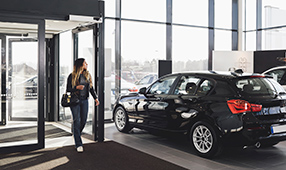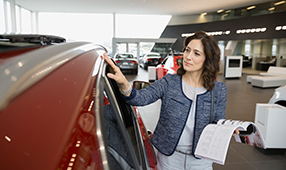Key takeaways
- Use online tools and resources to find the right car for your needs
- Consider often overlooked car costs including repairs, depreciation, and insurance
- Be sure the car you plan to buy is safe and has all the features you want
- Know how to negotiate to get the best price and terms on your next car
Your current vehicle may be running just fine, but it’s important to plan ahead so you’re not caught by surprise. Start researching now, before the big day comes, so you can confidently choose a car you’ll be happy with for as long as you plan to keep it. If possible, try to schedule your car-buying during the best times in your busy school year.
Use this 14-point car buying checklist to help you thoroughly research your future car now so you can get the best deal when it’s time to go buy your new ride.
ASSESS YOUR CURRENT SITUATION
1. Consider your overall budget
Take a look at your income and your current debt to calculate a realistic number for what you could afford. How much should you spend on a car? As a general rule of thumb, SmartAsset.com recommends spending no more than 15% of your monthly take-home pay on all auto expenses, less if you already have a lot of debt. This includes the extras, such as insurance and maintenance, which add to the expense. Read about the total cost of ownership to make sure the cars you’re eyeing are really within your range.
And even though it’s tempting to buy a car with no down payment, don’t. Making that first payment, according to Credit Karma, can help reduce your car payments and offset depreciation so you don’t owe more than your car is worth. Start saving now, if possible, so you’ll have it when the time comes. Consider opening a savings account for just this purpose and put a little away each paycheck.
2. Factor in future lifestyle changes
If you’re thinking of having a child or two in the next few years you might want to skip the sedan in favor of a minivan, for example. Think about your future family and career plans before you choose a car. NAPA offers tips to help you find the right fit for you today—and tomorrow—at Your Car Lifestyle.
“I’ve always thought of minivans as great cars for teachers,” says Brian Moody, executive editor at Autotrader. “Many are available and this would be an excellent choice for someone who doesn’t have a lot of time for research. They have lots of room inside for supplies and most vans have reconfigurable seating so even big class projects can fit easily,” he adds. Their low floors mean you don’t have to lift boxes of books or other heavy objects as high to load as you would with an SUV.
The downside? Cost. “A new Honda or Toyota van can easily run $35,000 or more,” Moody notes. For a budget-friendly alternative, “look for a good used or certified pre-owned minivan like a Kia Sedona” or a discontinued but still reliable van like the Hyundai Entourage and Nissan Quest.”
3. Determine how long you want to keep it
Do you typically hold on to a vehicle for a short time, or do you drive it until it dies? If you plan to swap it for a new car in a few years, make sure the make and model you buy will have good resale value by checking Kelley Blue Book car values. That resale money could be your next down payment.
START YOUR RESEARCH
4. Explore different makes and models
You may already be leaning toward a specific vehicle, whether you plan on replacing your current car with the same brand, or you’ve been eyeing a cute car in the parking lot at school. And as you browse, you’re bound to gravitate toward certain kinds of cars or SUVs. If not, there are scores of online tools to help you compare vehicles and narrow your list.
As an NEA member, you have access to information through the NEA Auto Buying Program, car buying service powered by TrueCar.
“TrueCar has great information on vehicles that buyers who don’t have to buy a car right away can use to start their research. You can search by brand or body style, sedan, SUV, or convertible for instance, or you can compare different vehicles side-by-side,” says Alain Nana-Sinkam, vice president of strategic initiatives at TrueCar.
You’ll also find tools to help you check car features, reviews and opinions at Edmunds, Kelley Blue Book, Autotrader, Consumer Reports and other sites.
5. Check your prospective cars’ total cost to own
Enter your ZIP code and the make, model, year (as far back as 2013) and style of your target cars into the Cost of Ownership tool at Edmunds to get an estimate that includes price, depreciation, insurance, financing, taxes and fees, fuel, maintenance, repairs and Federal tax credits. Make sure the numbers align with your budget—this may help you narrow down your choices.
6. Review track records and maintenance costs
Once you have a few vehicles in mind, start looking at their reliability records. A more reliable car will save you money on repairs as well as time and aggravation.
It’s also important to get an idea of what maintenance will cost, as this can vary.
Track record is especially important if you’re buying a used car. “You want to look at the vehicle history report, maintenance history and things like that,” says Ronald Montoya, senior consumer advice editor at Edmunds. Look up the car’s owner’s manual online to check maintenance services and intervals, then call dealer service departments or repair shops to learn what those jobs cost or check RepairPal, advises Edmunds used car buying tips.
Kelley Blue Book’s Fair Repair Range Estimator tool also shows dealership repair centers in your area and lets you look up the Blue Book Fair Repair Range cost of common repairs. Enter the car’s year, make, model and mileage, your zip code, and then choose the type of repair such as “battery.” Say you’re eyeing a 2017 Honda Accord with 20,000 miles and you want to know how much it costs to replace the battery in your hometown of Denver: The tool shows parts should cost $104 to $122 and labor $55 to $66. You can also select tabs to look for Recalls and Maintenance Schedules.
7. Keep gas mileage in mind
Commuting to school and driving to after-school activities can be an unwelcome added expense when gas prices are high, especially if you live far away. Visit FuelEconomy.gov to check gas prices, calculate (and track) your MPG and fuel savings, find and compare cars, learn about hybrids, electric and alternative fuel cars and more.
8. Choose a color you like—don’t worry about your insurance premiums
Red isn’t going to raise your auto insurance premium. “The notion that the color of your car affects your insurance rates is a bit of an urban legend,” Nana-Sinkam says. “Insurance companies factor your rates basically on two things: how likely are you going to be in an accident (your driving record, how far you drive, where you drive) and how much would it cost to fix or replace your car, or pay for any other damage or injuries, if it was in an accident.”
An outrageous color might affect your car’s resale value but it’s not likely to affect your insurance, Montoya agrees. However, if you can be flexible on color preference, you’ll often be able to make a better deal when you go to buy.
9. Learn about the pros and cons of different tires
Get a car with general, all-season tires for daily transportation, advises Jon Linkov, deputy cars editor for Consumer Reports. Performance doesn’t mean the tires are necessarily better, he notes. “They do a different job than an all season tire,” he explains, and “performance, performance all season or high performance [tires] are going to wear out quicker.”
“Many cars are starting to feature run-flat tires as standard equipment,” notes Nana-Sinkam. These tires allow you drive a certain distance after they go flat, so that you aren’t stuck out in the boonies with a flat tire. They also negate the need for an actual spare in your trunk, which reduces vehicle weight and reduces cost.”
But keep two factors in mind: “Make sure you know the restrictions on how far and fast you can drive” after your run-flat tire goes flat, Nana-Sinkam says, noting “each model varies.” And, he adds, damage from a nail or road hazard can sometimes be plugged on traditional tires but damaged run-flat tires can’t be fixed. “This means any damage to a run-flat is going to require replacement,” he cautions.
10. Research current safety features
“If you think you might need a car in the near future and want to be prepared—start looking at safety ratings by using safercar.gov,” says Moody.
Make sure the car you’re planning to buy is safe. Visit the National Highway Traffic Safety Administration for a wide range of safety information from air bag recalls to teen driving to school bus safety. (You can also sign up for email recall alerts to know if your vehicle, tires or car seat has a safety problem and how to get it fixed.)
Vehicle shoppers should check NHTSA’s safercar.gov section Vehicle Comparison Tool and 5-Star Safety Rating recommendations which covers driver assistance technologies (forward collision warning, lane departure waning, etc.), air bags, seat belts, tire pressure monitoring system and more.
If children will be riding in your car, KBB says “don’t buy any vehicle until you’re sure your car seat(s) fit well.” When you’re testing a car, bring your car seats along and install them in the vehicle you’re considering. Find details on what to look for at KBB’s Child Car Safety Seats.
TIPS FOR WHEN YOU’RE READY TO BUY
11. Pick the right time to buy a car
You’ve done your research and you’ve decided which car to want to buy. Whether you want to buy next month or next year, when can you get the best deal? All sorts of rumors have been floated about when to buy a car, says Montoya. Read Edmunds.com’s When to Buy Your Next Car to learn the facts.
Bottom line: The best discounts start in October and get progressively better through December. But, Montoya cautions, you have to balance those bigger discounts against more limited supply. The longer you wait, the greater the chance you’ll have less to choose from, Montoya explains.
Avoid buying at tax time when lots of people decide to spend their refunds on a new car. Look, kick the tires, and get price information in March or April, Linkov advises, but wait until May or June to buy.
The best time to negotiate is at the end of the month, any month, when dealers are a little more eager to make the sale so you can negotiate, Linkov notes.
Learn how to become a better car buyer with these negotiating tips. Or you can skip the hassle altogether and buy your car through the NEA Auto Buying Program.
12. Before you buy, ask about incentives and rebates
Always ask about incentives and rebates, no matter when you buy, Linkov says. One example: brand competition deals where a competing brand gives you an incentive to buy their car instead, he notes. Say you have a Honda now; a competition incentive from Toyota might give you money off a Toyota if you switch to their brand.
13. Talk in terms of the cost of the car, not the monthly payment
Negotiate the price of the car, not the payments, says Linkov. If the dealer says, “How much do you want to pay a month,” don’t go there. If you say you want to pay $269 a month and the dealer agrees, “you’ll pay $269 for that car, but you may pay $269 for six years and at some point you’ll owe more on the car than the car is worth,” Linkov explains. Instead, negotiate the price. Say, ‘I want to pay $28,000’ or whatever your target is, and negotiate that, advises Linkov. “You can always figure out the monthly cost after.”
Even though the average car costs $35,000 today, “don’t go beyond a four- or five-year loan,” Linkov warns. “Once you get to six years, you haven’t built up equity in the car so it depreciates and you owe more on a car than it’s worth,” he explains. “If you get in an accident, you actually have to pay more money because of that situation and that’s called being upside down.”
Bottom line, Linkov says, “If you have to go past five years to afford that car, you want to look for a cheaper vehicle.”
14. Make the deal!
Take a bow! You’ve done it. Now, relax and enjoy your new (or new-to-you used) car, knowing you’ve done your homework and have chosen a car that fits your needs today and will continue to be a good fit for as long as you plan to keep it.












